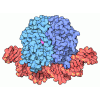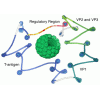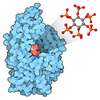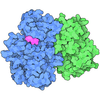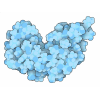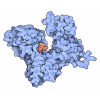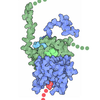+ データを開く
データを開く
- 基本情報
基本情報
| 登録情報 | データベース: PDB / ID: 8rbz | ||||||||||||
|---|---|---|---|---|---|---|---|---|---|---|---|---|---|
| タイトル | Structure of Integrator-PP2A-SOSS-CTD post-termination complex | ||||||||||||
 要素 要素 |
| ||||||||||||
 キーワード キーワード | TRANSCRIPTION / Integrator complex / Post-termination complex / RNA Polymerase II / Pol II / RNAPII | ||||||||||||
| 機能・相同性 |  機能・相同性情報 機能・相同性情報SOSS complex / U2 snRNA 3'-end processing / regulation of fertilization / meiotic spindle elongation / Integration of energy metabolism / snRNA 3'-end processing / PP2A-mediated dephosphorylation of key metabolic factors / RNA polymerase II CTD heptapeptide repeat S2 phosphatase activity / RNA polymerase II CTD heptapeptide repeat S7 phosphatase activity / MASTL Facilitates Mitotic Progression ...SOSS complex / U2 snRNA 3'-end processing / regulation of fertilization / meiotic spindle elongation / Integration of energy metabolism / snRNA 3'-end processing / PP2A-mediated dephosphorylation of key metabolic factors / RNA polymerase II CTD heptapeptide repeat S2 phosphatase activity / RNA polymerase II CTD heptapeptide repeat S7 phosphatase activity / MASTL Facilitates Mitotic Progression / establishment of protein localization to telomere / protein phosphatase type 2A complex / protein serine/threonine phosphatase complex / peptidyl-threonine dephosphorylation / regulation of meiotic cell cycle process involved in oocyte maturation / mitotic sister chromatid separation / meiotic sister chromatid cohesion, centromeric / snRNA processing / INTAC complex / RNA polymerase II CTD heptapeptide repeat S5 phosphatase activity / FAR/SIN/STRIPAK complex / protein localization to nuclear envelope / Regulation of glycolysis by fructose 2,6-bisphosphate metabolism / Inhibition of replication initiation of damaged DNA by RB1/E2F1 / female meiotic nuclear division / eye development / regulation of transcription elongation by RNA polymerase II / protein phosphatase regulator activity / GABA receptor binding / flagellated sperm motility / integrator complex / APC truncation mutants have impaired AXIN binding / AXIN missense mutants destabilize the destruction complex / Truncations of AMER1 destabilize the destruction complex / protein antigen binding / positive regulation of telomere capping / ERKs are inactivated / Formation of RNA Pol II elongation complex / Formation of the Early Elongation Complex / Transcriptional regulation by small RNAs / RNA Polymerase II Pre-transcription Events / TP53 Regulates Transcription of DNA Repair Genes / FGFR2 alternative splicing / RNA polymerase II transcribes snRNA genes / mRNA Capping / mRNA Splicing - Minor Pathway / Processing of Capped Intron-Containing Pre-mRNA / RNA Polymerase II Promoter Escape / RNA Polymerase II Transcription Pre-Initiation And Promoter Opening / RNA Polymerase II Transcription Initiation / RNA Polymerase II Transcription Elongation / RNA Polymerase II Transcription Initiation And Promoter Clearance / RNA Pol II CTD phosphorylation and interaction with CE / Estrogen-dependent gene expression / Formation of TC-NER Pre-Incision Complex / Dual incision in TC-NER / Gap-filling DNA repair synthesis and ligation in TC-NER / mRNA Splicing - Major Pathway / 加水分解酵素; エステル加水分解酵素; 3'-リン酸モノエステル産生エンドリボヌクレアーゼ / positive regulation of extrinsic apoptotic signaling pathway in absence of ligand / Initiation of Nuclear Envelope (NE) Reformation / Beta-catenin phosphorylation cascade / Signaling by GSK3beta mutants / CTNNB1 S33 mutants aren't phosphorylated / CTNNB1 S37 mutants aren't phosphorylated / CTNNB1 S45 mutants aren't phosphorylated / CTNNB1 T41 mutants aren't phosphorylated / mitotic G2/M transition checkpoint / G-rich strand telomeric DNA binding / RNA polymerase II transcription initiation surveillance / Co-stimulation by CD28 / regulation of growth / Disassembly of the destruction complex and recruitment of AXIN to the membrane / centrosome localization / negative regulation of epithelial to mesenchymal transition / inner cell mass cell proliferation / Co-inhibition by CTLA4 / Platelet sensitization by LDL / response to ionizing radiation / protein-serine/threonine phosphatase / negative regulation of glycolytic process through fructose-6-phosphate / positive regulation of NLRP3 inflammasome complex assembly / ERK/MAPK targets / protein serine/threonine phosphatase activity / mesoderm development / vascular endothelial cell response to oscillatory fluid shear stress / T cell homeostasis / regulation of cell differentiation / regulation of microtubule polymerization / phosphoprotein phosphatase activity / regulation of G1/S transition of mitotic cell cycle / RNA polymerase II transcribes snRNA genes / lateral plasma membrane / chromosome, centromeric region / DARPP-32 events / negative regulation of hippo signaling / core promoter sequence-specific DNA binding / protein dephosphorylation / Nonsense Mediated Decay (NMD) enhanced by the Exon Junction Complex (EJC) / RNA polymerase II, core complex 類似検索 - 分子機能 | ||||||||||||
| 生物種 |  Homo sapiens (ヒト) Homo sapiens (ヒト)  Trichoplusia ni (イラクサキンウワバ) Trichoplusia ni (イラクサキンウワバ) | ||||||||||||
| 手法 | 電子顕微鏡法 / 単粒子再構成法 / クライオ電子顕微鏡法 / 解像度: 3.7 Å | ||||||||||||
 データ登録者 データ登録者 | Fianu, I. / Ochmann, M. / Walshe, J.L. / Cramer, P. | ||||||||||||
| 資金援助 |  ドイツ, European Union, 3件 ドイツ, European Union, 3件
| ||||||||||||
 引用 引用 |  ジャーナル: Nature / 年: 2024 ジャーナル: Nature / 年: 2024タイトル: Structural basis of Integrator-dependent RNA polymerase II termination. 著者: Isaac Fianu / Moritz Ochmann / James L Walshe / Olexandr Dybkov / Joseph Neos Cruz / Henning Urlaub / Patrick Cramer /  要旨: The Integrator complex can terminate RNA polymerase II (Pol II) in the promoter-proximal region of genes. Previous work has shed light on how Integrator binds to the paused elongation complex ...The Integrator complex can terminate RNA polymerase II (Pol II) in the promoter-proximal region of genes. Previous work has shed light on how Integrator binds to the paused elongation complex consisting of Pol II, the DRB sensitivity-inducing factor (DSIF) and the negative elongation factor (NELF) and how it cleaves the nascent RNA transcript, but has not explained how Integrator removes Pol II from the DNA template. Here we present three cryo-electron microscopy structures of the complete Integrator-PP2A complex in different functional states. The structure of the pre-termination complex reveals a previously unresolved, scorpion-tail-shaped INTS10-INTS13-INTS14-INTS15 module that may use its 'sting' to open the DSIF DNA clamp and facilitate termination. The structure of the post-termination complex shows that the previously unresolved subunit INTS3 and associated sensor of single-stranded DNA complex (SOSS) factors prevent Pol II rebinding to Integrator after termination. The structure of the free Integrator-PP2A complex in an inactive closed conformation reveals that INTS6 blocks the PP2A phosphatase active site. These results lead to a model for how Integrator terminates Pol II transcription in three steps that involve major rearrangements. | ||||||||||||
| 履歴 |
|
- 構造の表示
構造の表示
| 構造ビューア | 分子:  Molmil Molmil Jmol/JSmol Jmol/JSmol |
|---|
- ダウンロードとリンク
ダウンロードとリンク
- ダウンロード
ダウンロード
| PDBx/mmCIF形式 |  8rbz.cif.gz 8rbz.cif.gz | 1.7 MB | 表示 |  PDBx/mmCIF形式 PDBx/mmCIF形式 |
|---|---|---|---|---|
| PDB形式 |  pdb8rbz.ent.gz pdb8rbz.ent.gz | 1.3 MB | 表示 |  PDB形式 PDB形式 |
| PDBx/mmJSON形式 |  8rbz.json.gz 8rbz.json.gz | ツリー表示 |  PDBx/mmJSON形式 PDBx/mmJSON形式 | |
| その他 |  その他のダウンロード その他のダウンロード |
-検証レポート
| 文書・要旨 |  8rbz_validation.pdf.gz 8rbz_validation.pdf.gz | 1.3 MB | 表示 |  wwPDB検証レポート wwPDB検証レポート |
|---|---|---|---|---|
| 文書・詳細版 |  8rbz_full_validation.pdf.gz 8rbz_full_validation.pdf.gz | 1.3 MB | 表示 | |
| XML形式データ |  8rbz_validation.xml.gz 8rbz_validation.xml.gz | 209.6 KB | 表示 | |
| CIF形式データ |  8rbz_validation.cif.gz 8rbz_validation.cif.gz | 362 KB | 表示 | |
| アーカイブディレクトリ |  https://data.pdbj.org/pub/pdb/validation_reports/rb/8rbz https://data.pdbj.org/pub/pdb/validation_reports/rb/8rbz ftp://data.pdbj.org/pub/pdb/validation_reports/rb/8rbz ftp://data.pdbj.org/pub/pdb/validation_reports/rb/8rbz | HTTPS FTP |
-関連構造データ
| 関連構造データ |  19040MC  8rbxC  8rc4C C: 同じ文献を引用 ( M: このデータのモデリングに利用したマップデータ |
|---|---|
| 類似構造データ | 類似検索 - 機能・相同性  F&H 検索 F&H 検索 |
- リンク
リンク
- 集合体
集合体
| 登録構造単位 | 
|
|---|---|
| 1 |
|
- 要素
要素
-タンパク質・ペプチド , 3種, 3分子 1Yr
| #1: タンパク質・ペプチド | 分子量: 783.958 Da / 分子数: 1 / 由来タイプ: 天然 / 由来: (天然)  |
|---|---|
| #4: タンパク質・ペプチド | 分子量: 1356.393 Da / 分子数: 1 / 由来タイプ: 天然 / 由来: (天然)  |
| #20: タンパク質・ペプチド | 分子量: 3383.542 Da / 分子数: 1 / 由来タイプ: 天然 由来: (天然)  Trichoplusia ni (イラクサキンウワバ) Trichoplusia ni (イラクサキンウワバ) |
-SOSS complex subunit ... , 2種, 2分子 BC
| #2: タンパク質 | 分子量: 22566.053 Da / 分子数: 1 / 由来タイプ: 組換発現 / 由来: (組換発現)  Homo sapiens (ヒト) / 遺伝子: NABP2 / 発現宿主: Homo sapiens (ヒト) / 遺伝子: NABP2 / 発現宿主:  Trichoplusia ni (イラクサキンウワバ) / 参照: UniProt: Q9BQ15 Trichoplusia ni (イラクサキンウワバ) / 参照: UniProt: Q9BQ15 |
|---|---|
| #3: タンパク質 | 分子量: 11642.977 Da / 分子数: 1 / 由来タイプ: 組換発現 / 由来: (組換発現)  Homo sapiens (ヒト) / 遺伝子: INIP / 発現宿主: Homo sapiens (ヒト) / 遺伝子: INIP / 発現宿主:  Trichoplusia ni (イラクサキンウワバ) / 参照: UniProt: Q9NRY2 Trichoplusia ni (イラクサキンウワバ) / 参照: UniProt: Q9NRY2 |
-Integrator complex subunit ... , 14種, 14分子 abcdefghijknom
| #5: タンパク質 | 分子量: 244776.078 Da / 分子数: 1 / 由来タイプ: 組換発現 / 由来: (組換発現)  Homo sapiens (ヒト) / 遺伝子: INTS1 / 発現宿主: Homo sapiens (ヒト) / 遺伝子: INTS1 / 発現宿主:  Trichoplusia ni (イラクサキンウワバ) / 参照: UniProt: Q8N201 Trichoplusia ni (イラクサキンウワバ) / 参照: UniProt: Q8N201 |
|---|---|
| #6: タンパク質 | 分子量: 134451.625 Da / 分子数: 1 / 由来タイプ: 組換発現 / 由来: (組換発現)  Homo sapiens (ヒト) / 遺伝子: INTS2, KIAA1287 / 発現宿主: Homo sapiens (ヒト) / 遺伝子: INTS2, KIAA1287 / 発現宿主:  Trichoplusia ni (イラクサキンウワバ) / 参照: UniProt: Q9H0H0 Trichoplusia ni (イラクサキンウワバ) / 参照: UniProt: Q9H0H0 |
| #7: タンパク質 | 分子量: 118155.555 Da / 分子数: 1 / 由来タイプ: 組換発現 / 由来: (組換発現)  Homo sapiens (ヒト) / 遺伝子: INTS3 / 発現宿主: Homo sapiens (ヒト) / 遺伝子: INTS3 / 発現宿主:  Trichoplusia ni (イラクサキンウワバ) / 参照: UniProt: Q68E01 Trichoplusia ni (イラクサキンウワバ) / 参照: UniProt: Q68E01 |
| #8: タンパク質 | 分子量: 108306.758 Da / 分子数: 1 / 由来タイプ: 組換発現 / 由来: (組換発現)  Homo sapiens (ヒト) / 遺伝子: INTS4, MSTP093 / 発現宿主: Homo sapiens (ヒト) / 遺伝子: INTS4, MSTP093 / 発現宿主:  Trichoplusia ni (イラクサキンウワバ) / 参照: UniProt: Q96HW7 Trichoplusia ni (イラクサキンウワバ) / 参照: UniProt: Q96HW7 |
| #9: タンパク質 | 分子量: 108316.422 Da / 分子数: 1 / 由来タイプ: 組換発現 / 由来: (組換発現)  Homo sapiens (ヒト) / 遺伝子: INTS5 / 発現宿主: Homo sapiens (ヒト) / 遺伝子: INTS5 / 発現宿主:  Trichoplusia (蝶・蛾) / 参照: UniProt: Q6P9B9 Trichoplusia (蝶・蛾) / 参照: UniProt: Q6P9B9 |
| #10: タンパク質 | 分子量: 100728.250 Da / 分子数: 1 / 由来タイプ: 組換発現 / 由来: (組換発現)  Homo sapiens (ヒト) / 遺伝子: INTS6 / 発現宿主: Homo sapiens (ヒト) / 遺伝子: INTS6 / 発現宿主:  Trichoplusia ni (イラクサキンウワバ) / 参照: UniProt: Q9UL03 Trichoplusia ni (イラクサキンウワバ) / 参照: UniProt: Q9UL03 |
| #11: タンパク質 | 分子量: 107153.805 Da / 分子数: 1 / 由来タイプ: 組換発現 / 由来: (組換発現)  Homo sapiens (ヒト) / 遺伝子: INTS7 / 発現宿主: Homo sapiens (ヒト) / 遺伝子: INTS7 / 発現宿主:  Trichoplusia ni (イラクサキンウワバ) / 参照: UniProt: Q9NVH2 Trichoplusia ni (イラクサキンウワバ) / 参照: UniProt: Q9NVH2 |
| #12: タンパク質 | 分子量: 113219.859 Da / 分子数: 1 / 由来タイプ: 組換発現 / 由来: (組換発現)  Homo sapiens (ヒト) / 遺伝子: INTS8, C8orf52 / 発現宿主: Homo sapiens (ヒト) / 遺伝子: INTS8, C8orf52 / 発現宿主:  Trichoplusia ni (イラクサキンウワバ) / 参照: UniProt: Q75QN2 Trichoplusia ni (イラクサキンウワバ) / 参照: UniProt: Q75QN2 |
| #13: タンパク質 | 分子量: 73891.219 Da / 分子数: 1 / 由来タイプ: 組換発現 / 由来: (組換発現)  Homo sapiens (ヒト) / 遺伝子: INTS9, RC74 / 発現宿主: Homo sapiens (ヒト) / 遺伝子: INTS9, RC74 / 発現宿主:  Trichoplusia ni (イラクサキンウワバ) / 参照: UniProt: Q9NV88 Trichoplusia ni (イラクサキンウワバ) / 参照: UniProt: Q9NV88 |
| #14: タンパク質 | 分子量: 82339.867 Da / 分子数: 1 / 由来タイプ: 組換発現 / 由来: (組換発現)  Homo sapiens (ヒト) / 遺伝子: INTS10, C8orf35 / 発現宿主: Homo sapiens (ヒト) / 遺伝子: INTS10, C8orf35 / 発現宿主:  Trichoplusia ni (イラクサキンウワバ) / 参照: UniProt: Q9NVR2 Trichoplusia ni (イラクサキンウワバ) / 参照: UniProt: Q9NVR2 |
| #15: タンパク質 | 分子量: 67970.781 Da / 分子数: 1 / 由来タイプ: 組換発現 / 由来: (組換発現)  Homo sapiens (ヒト) / 遺伝子: INTS11 / 発現宿主: Homo sapiens (ヒト) / 遺伝子: INTS11 / 発現宿主:  Trichoplusia ni (イラクサキンウワバ) / 参照: UniProt: Q5TA45 Trichoplusia ni (イラクサキンウワバ) / 参照: UniProt: Q5TA45 |
| #16: タンパク質 | 分子量: 57526.547 Da / 分子数: 1 / 由来タイプ: 組換発現 / 由来: (組換発現)  Homo sapiens (ヒト) / 遺伝子: INTS14, C15orf44, VWA9 / 発現宿主: Homo sapiens (ヒト) / 遺伝子: INTS14, C15orf44, VWA9 / 発現宿主:  Trichoplusia ni (イラクサキンウワバ) / 参照: UniProt: Q96SY0 Trichoplusia ni (イラクサキンウワバ) / 参照: UniProt: Q96SY0 |
| #17: タンパク質 | 分子量: 50303.582 Da / 分子数: 1 / 由来タイプ: 組換発現 / 由来: (組換発現)  Homo sapiens (ヒト) / 遺伝子: INTS15 / 発現宿主: Homo sapiens (ヒト) / 遺伝子: INTS15 / 発現宿主:  Trichoplusia ni (イラクサキンウワバ) / 参照: UniProt: Q96N11 Trichoplusia ni (イラクサキンウワバ) / 参照: UniProt: Q96N11 |
| #21: タンパク質 | 分子量: 80345.180 Da / 分子数: 1 / 由来タイプ: 組換発現 / 由来: (組換発現)  Homo sapiens (ヒト) / 遺伝子: INTS13, ASUN, C12orf11, GCT1 / 発現宿主: Homo sapiens (ヒト) / 遺伝子: INTS13, ASUN, C12orf11, GCT1 / 発現宿主:  Trichoplusia ni (イラクサキンウワバ) / 参照: UniProt: Q9NVM9 Trichoplusia ni (イラクサキンウワバ) / 参照: UniProt: Q9NVM9 |
-Serine/threonine-protein phosphatase 2A ... , 2種, 2分子 pq
| #18: タンパク質 | 分子量: 65579.531 Da / 分子数: 1 / 由来タイプ: 組換発現 / 由来: (組換発現)  Homo sapiens (ヒト) / 遺伝子: PPP2R1A / 発現宿主: Homo sapiens (ヒト) / 遺伝子: PPP2R1A / 発現宿主:  Trichoplusia ni (イラクサキンウワバ) / 参照: UniProt: P30153 Trichoplusia ni (イラクサキンウワバ) / 参照: UniProt: P30153 |
|---|---|
| #19: タンパク質 | 分子量: 35836.348 Da / 分子数: 1 / 由来タイプ: 組換発現 / 由来: (組換発現)  Homo sapiens (ヒト) / 遺伝子: PPP2CA / 発現宿主: Homo sapiens (ヒト) / 遺伝子: PPP2CA / 発現宿主:  Trichoplusia ni (イラクサキンウワバ) / 参照: UniProt: P67775 Trichoplusia ni (イラクサキンウワバ) / 参照: UniProt: P67775 |
-非ポリマー , 2種, 4分子 


| #22: 化合物 | | #23: 化合物 | |
|---|
-詳細
| 研究の焦点であるリガンドがあるか | N |
|---|
-実験情報
-実験
| 実験 | 手法: 電子顕微鏡法 |
|---|---|
| EM実験 | 試料の集合状態: PARTICLE / 3次元再構成法: 単粒子再構成法 |
- 試料調製
試料調製
| 構成要素 |
| |||||||||||||||||||||||||||||||||||
|---|---|---|---|---|---|---|---|---|---|---|---|---|---|---|---|---|---|---|---|---|---|---|---|---|---|---|---|---|---|---|---|---|---|---|---|---|
| 分子量 | 値: 1.2 MDa / 実験値: NO | |||||||||||||||||||||||||||||||||||
| 由来(天然) |
| |||||||||||||||||||||||||||||||||||
| 由来(組換発現) | 生物種:  Trichoplusia ni (イラクサキンウワバ) Trichoplusia ni (イラクサキンウワバ) | |||||||||||||||||||||||||||||||||||
| 緩衝液 | pH: 7.4 | |||||||||||||||||||||||||||||||||||
| 試料 | 濃度: 0.3 mg/ml / 包埋: NO / シャドウイング: NO / 染色: NO / 凍結: YES | |||||||||||||||||||||||||||||||||||
| 急速凍結 | 凍結剤: ETHANE |
- 電子顕微鏡撮影
電子顕微鏡撮影
| 実験機器 |  モデル: Titan Krios / 画像提供: FEI Company |
|---|---|
| 顕微鏡 | モデル: FEI TITAN KRIOS |
| 電子銃 | 電子線源:  FIELD EMISSION GUN / 加速電圧: 300 kV / 照射モード: OTHER FIELD EMISSION GUN / 加速電圧: 300 kV / 照射モード: OTHER |
| 電子レンズ | モード: OTHER / 最大 デフォーカス(公称値): 2000 nm / 最小 デフォーカス(公称値): 500 nm |
| 撮影 | 電子線照射量: 39.93 e/Å2 / フィルム・検出器のモデル: GATAN K3 (6k x 4k) |
- 解析
解析
| EMソフトウェア | 名称: PHENIX / バージョン: 1.20.1_4487: / カテゴリ: モデル精密化 | ||||||||||||||||||
|---|---|---|---|---|---|---|---|---|---|---|---|---|---|---|---|---|---|---|---|
| CTF補正 | タイプ: NONE | ||||||||||||||||||
| 3次元再構成 | 解像度: 3.7 Å / 解像度の算出法: FSC 0.143 CUT-OFF / 粒子像の数: 236382 / 対称性のタイプ: POINT | ||||||||||||||||||
| 原子モデル構築 |
| ||||||||||||||||||
| 原子モデル構築 |
|
 ムービー
ムービー コントローラー
コントローラー





 PDBj
PDBj


